Mostrar el registro sencillo del ítem
dc.contributor.author
Díaz, Sonia Beatriz

dc.contributor.author
Ale, Norma Mercedes

dc.contributor.author
Ben Altabef, Aída

dc.contributor.author
Tymczyszyn, Emma Elizabeth

dc.contributor.author
Gomez Zavaglia, Andrea

dc.date.available
2018-04-05T14:26:56Z
dc.date.issued
2017-05
dc.identifier.citation
Díaz, Sonia Beatriz; Ale, Norma Mercedes; Ben Altabef, Aída; Tymczyszyn, Emma Elizabeth; Gomez Zavaglia, Andrea; Interaction of galacto-oligosaccharides and lactulose with dipalmitoylphosphatidilcholine lipid membranes as determined by infrared spectroscopy; Royal Chemical Society; RSC; 7; 39; 5-2017; 24298-24304
dc.identifier.issn
2046-2069
dc.identifier.uri
http://hdl.handle.net/11336/40842
dc.description.abstract
Lactulose and galacto-oligosaccharides (GOS) have been recognized as health promoting compounds due to their recognized prebiotic capacity. In addition, because of their polyhydroxilated nature, they are effective protectants during processes involving dehydration of lactic acid bacteria. The protective effects of sugars have been associated with their capacity to replace water molecules from lipid membranes and/or to form glassy matrices. Although this latter property has been previously investigated for GOS and lactulose, the capacity of these sugars to replace water molecules was not. Furthermore, it must be considered that GOS are usually mixtures of oligo-saccharides with differentdegrees of polymerization (DP) including or excluding different amounts of mono and disaccharides, and the effect of their composition on the GOS-membrane interaction has not been addressed so far. The aim of the present work was to study the interaction of lactulose and GOS of different compositions with dipalmitoylphosphatidilcholine (DPPC) membranes both in the gel (Lb) and in the liquid crystalline phase (La) by using infrared spectroscopy. Both GOS and lactulose interacted with the phosphate groups of the polar head region, but only lactulose (disaccharide) penetrated into the lipid bilayers anddecreased the membrane phase transition (Tm). In contrast, GOS containing no mono and disaccharides were excluded from the hydrophobic region, leading to an increase of the Tm. In turn, GOS containing mono and disaccharides showed a concentration-dependent effect. The results obtained shed light on the mechanisms involved in protection mediated by GOS and lactulose, thus providing support to improve the stabilization of lactic acid bacteria.
dc.format
application/pdf
dc.language.iso
eng
dc.publisher
Royal Chemical Society
dc.rights
info:eu-repo/semantics/openAccess
dc.rights.uri
https://creativecommons.org/licenses/by-nc-sa/2.5/ar/
dc.subject
Gos
dc.subject
Lactolose
dc.subject
Dppc
dc.subject
Membrane
dc.subject.classification
Otras Ciencias Químicas

dc.subject.classification
Ciencias Químicas

dc.subject.classification
CIENCIAS NATURALES Y EXACTAS

dc.subject.classification
Otras Ciencias Químicas

dc.subject.classification
Ciencias Químicas

dc.subject.classification
CIENCIAS NATURALES Y EXACTAS

dc.title
Interaction of galacto-oligosaccharides and lactulose with dipalmitoylphosphatidilcholine lipid membranes as determined by infrared spectroscopy
dc.type
info:eu-repo/semantics/article
dc.type
info:ar-repo/semantics/artículo
dc.type
info:eu-repo/semantics/publishedVersion
dc.date.updated
2018-04-04T14:18:00Z
dc.journal.volume
7
dc.journal.number
39
dc.journal.pagination
24298-24304
dc.journal.pais
Reino Unido

dc.journal.ciudad
London
dc.description.fil
Fil: Díaz, Sonia Beatriz. Universidad Nacional de Tucuman. Facultad de Bioquímica, Química y Farmacia. Instituto de Química Física; Argentina
dc.description.fil
Fil: Ale, Norma Mercedes. Universidad Nacional de Tucuman. Facultad de Bioquímica, Química y Farmacia. Instituto de Química Física; Argentina
dc.description.fil
Fil: Ben Altabef, Aída. Consejo Nacional de Investigaciones Científicas y Técnicas. Centro Científico Tecnológico Conicet - Tucumán. Instituto de Química del Noroeste. Universidad Nacional de Tucumán. Facultad de Bioquímica, Química y Farmacia. Instituto de Química del Noroeste; Argentina. Universidad Nacional de Tucuman. Facultad de Bioquímica, Química y Farmacia. Instituto de Química Física; Argentina
dc.description.fil
Fil: Tymczyszyn, Emma Elizabeth. Consejo Nacional de Investigaciones Científicas y Técnicas; Argentina. Universidad Nacional de Quilmes. Departamento de Ciencia y Tecnología. Laboratorio de Microbiología Molecular; Argentina
dc.description.fil
Fil: Gomez Zavaglia, Andrea. Provincia de Buenos Aires. Gobernación. Comisión de Investigaciones Científicas. Centro de Investigación y Desarrollo en Criotecnología de Alimentos. Consejo Nacional de Investigaciones Científicas y Técnicas. Centro Científico Tecnológico Conicet - La Plata. Centro de Investigación y Desarrollo en Criotecnología de Alimentos. Universidad Nacional de La Plata. Facultad de Ciencias Exactas. Centro de Investigación y Desarrollo en Criotecnología de Alimentos; Argentina
dc.journal.title
RSC
dc.relation.alternativeid
info:eu-repo/semantics/altIdentifier/doi/http://dx.doi.org/10.1039/C7RA01964E
dc.relation.alternativeid
info:eu-repo/semantics/altIdentifier/url/http://pubs.rsc.org/en/Content/ArticleLanding/2017/RA/C7RA01964E
Archivos asociados
